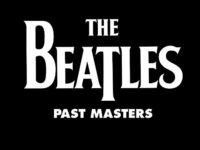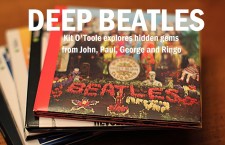Recorded during the Abbey Road sessions, “Old Brown Shoe” remains a quirky George Harrison’s composition that displays his great love of wordplay. While the Beatles released the track as the B-side to the May 1969 single “The Ballad of John and Yoko,” “Old Brown Shoe” dates back to the Get Back sessions and represents an important aspect of Harrison’s songwriting: humor.
In his autobiography I, Me, Mine, Harrison recalls composing the song on piano—an atypical method for his writing process: “I started the chord sequences on the piano, which I don’t really play, and then began writing ideas for the words from various opposites. … Again, it’s the duality of things — yes no, up down, left right, right wrong, etc.,” he said. Harrison and the group (including guest Billy Preston) first attempted the song on Jan. 27, 1969, returning to the track Jan. 28 and 29. These early versions differ only slightly from the final rendition, demonstrating how Harrison fully envisioned “Old Brown Shoe” from its earliest stages.
A victim of the Get Back sessions frustration, “Old Brown Shoe” was shelved, only to be revived on Feb. 25. On his 26th birthday, Harrison recorded solo demos of “Old Brown Shoe,” “Something,” and “All Things Must Pass,” with “Old Brown Shoe” featuring vocals, piano, and several guitar overdubs.
It took almost two months before the group revisited the song; on April 16, Harrison recorded a second demo in the morning, and the Beatles completed four takes by that evening. John Lennon provided rhythm guitar and backing vocals, while Paul McCartney contributed piano, guitar, and vocals. Ringo Starr played drums, as usual. Harrison played a seemingly uncommon (for him) instrument: the bass. In a 1988 interview for Creem, he stated “that was me going nuts. I’m doing exactly what I do on the guitar.”
To achieve a more intimate sound, Harrison recorded his lead vocals in a corner of the studio; this technique faintly echoes the recording method he used on “Not Guilty,” a White Album outtake. Two days later, an additional Hammond organ part performed by Harrison replaced Lennon’s rhythm guitar track. Ultimately, “The Ballad of John and Yoko/Old Brown Shoe” single was released on May 30 in the UK, and then June 4 in the US.
Ian MacDonald praises the track in Revolution in the Head, stating it “opens with [Harrison’s] sharpest lyric couplet and develops into one of his more forceful pieces.” Citing its Dylan-esque ironic lyrics, MacDonald proclaims it “an archetypal B-side from an era when B-sides were worth flipping a single for.” “Old Brown Shoe” has been occasionally overlooked due to its initial status as a B-side only, but finally received more attention when released as part of the Hey Jude compilation in 1970; today, the song is included on the Past Masters collection.
“Old Brown Shoe” stands alone, sounding unlike anything the Beatles recorded. = With its shuffling beat and nod to blues tropes, it features confident and ebullient singing from Harrison. The galloping piano pounds with the drums, establishing the beat that mimics his vocal lead vocal. Right away Harrison indulges in wordplay he enjoys: “I want a love that’s right / But right is only half of what’s wrong,” he virtually chants. Further emphasizing indecisiveness, he proclaims “I want a short haired girl / Who sometimes wears it twice as long.” He declares that since his lover has arrived “it won’t be the same now / I’m telling you.”
The lyrics take a serious turn in the second verse, describing how his lover cheers him and that her smile “replace[s] every thoughtless frown.” Interestingly, he adds that the woman has him “escaping from this zoo,” perhaps a commentary on the troubles the Beatles were experiencing at the time. (McCartney would similarly express a desire for escapism in his Abbey Road composition “You Never Give Me Your Money.”) Harrison returns to his signature absurdist humor toward the end of the track, using amusing rhymes that presage his work with the Traveling Wilburys: “For your sweet top lip I’m in the queue / Baby I’m in love with you.”
The bridge adds funky flavor to the track, with Harrison’s frenetic bass contributing to the song’s sudden sense of urgency. As Lennon and McCartney harmonize with Harrison on certain lines, Harrison also claims that “I’m changing faster than the weather.” After a country-tinged twangy guitar solo, he continues with his citation of opposites (love/hate, early/late). The Beatles jam as the song fades out, the music emitting joy in a time of turbulence within the band. The echo in Harrison’s voice simulates sitting in the studio with the group, hearing them perform the song in person.
“Old Brown Shoe” would not mark the first time George Harrison explored dichotomies in lyrics. In yet another B-side, Harrison used the seemingly contradictory phrase “arrive without traveling” in “The Inner Light.” During the solo years, Harrison contained experimenting with opposites in tracks such as Gone Troppo’s “Circles”: “When loss and gain and up and down / Becomes the same, then we stop going in circles.” In other words, dichotomies such as life and death become irrelevant, in his view, when it comes to reincarnation or the afterlife. In addition, the dominant piano recalls the dissonant chords pervading “I Want to Tell You,” which also foreshadows the haunting piano riff in “When We Was Fab.”
Thankfully, Harrison restored interest in this lesser-known song during his 1991 Japanese tour with Eric Clapton. He turned in a sprightly version with boosted backing vocals, which is captured on the Live in Japan two-album set. After his death, “Old Brown Shoe” was performed by Gary Brooker at the Concert for George and Conan O’Brien for 2014’s George Fest tribute.
Indeed, “Old Brown Shoe” has emerged from the shadow of being the B-side to the hit “The Ballad of John and Yoko” and is finally being recognized as one of George Harrison’s most underrated — and clever — compositions.
- How John Lennon Came Roaring Back on the Beatles’ White Album - November 22, 2023
- Five ‘With the Beatles’ Deep Cuts That Illustrate Their Lasting Debt to R&B - November 20, 2023
- Five Must-Hear Deep Cuts from the Beatles’ ‘Past Masters’ - March 7, 2023



